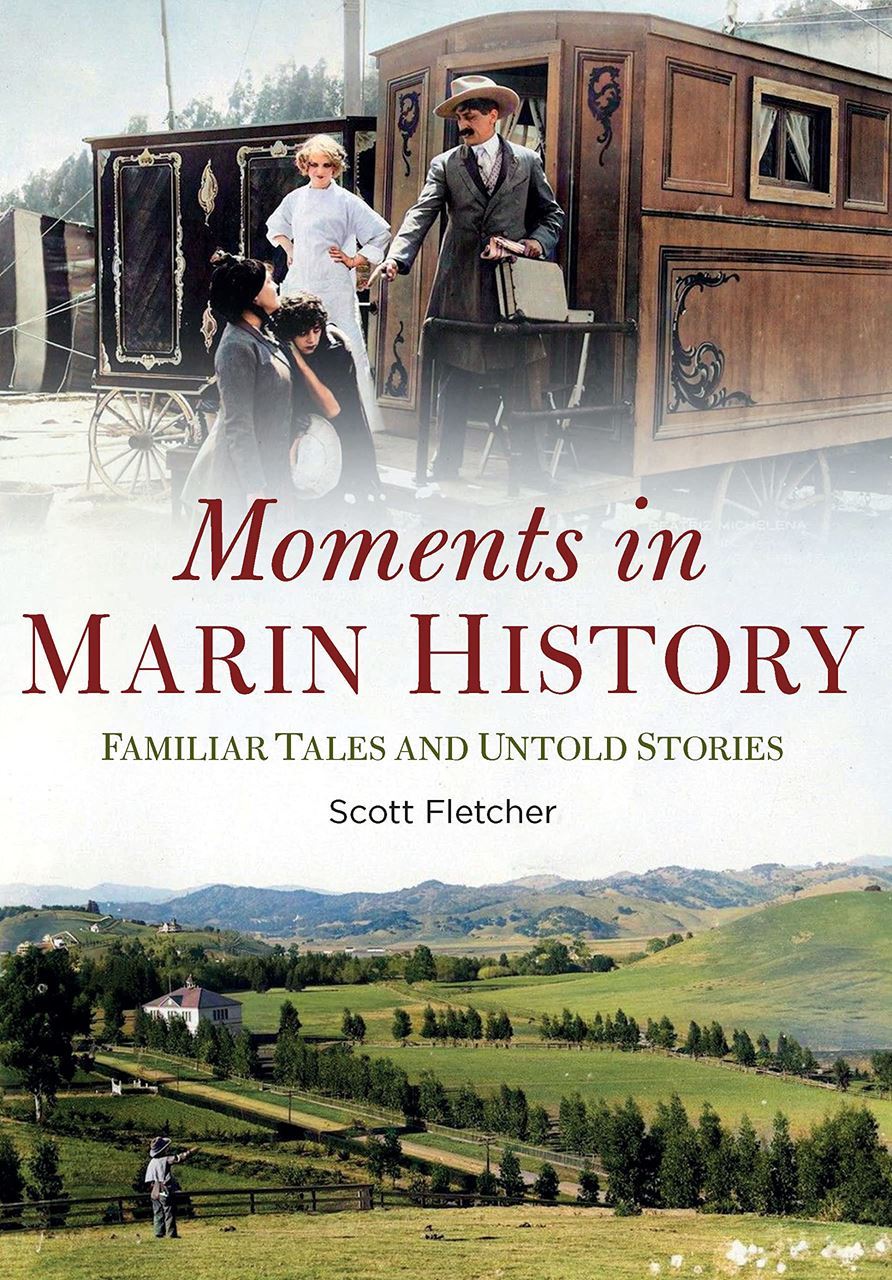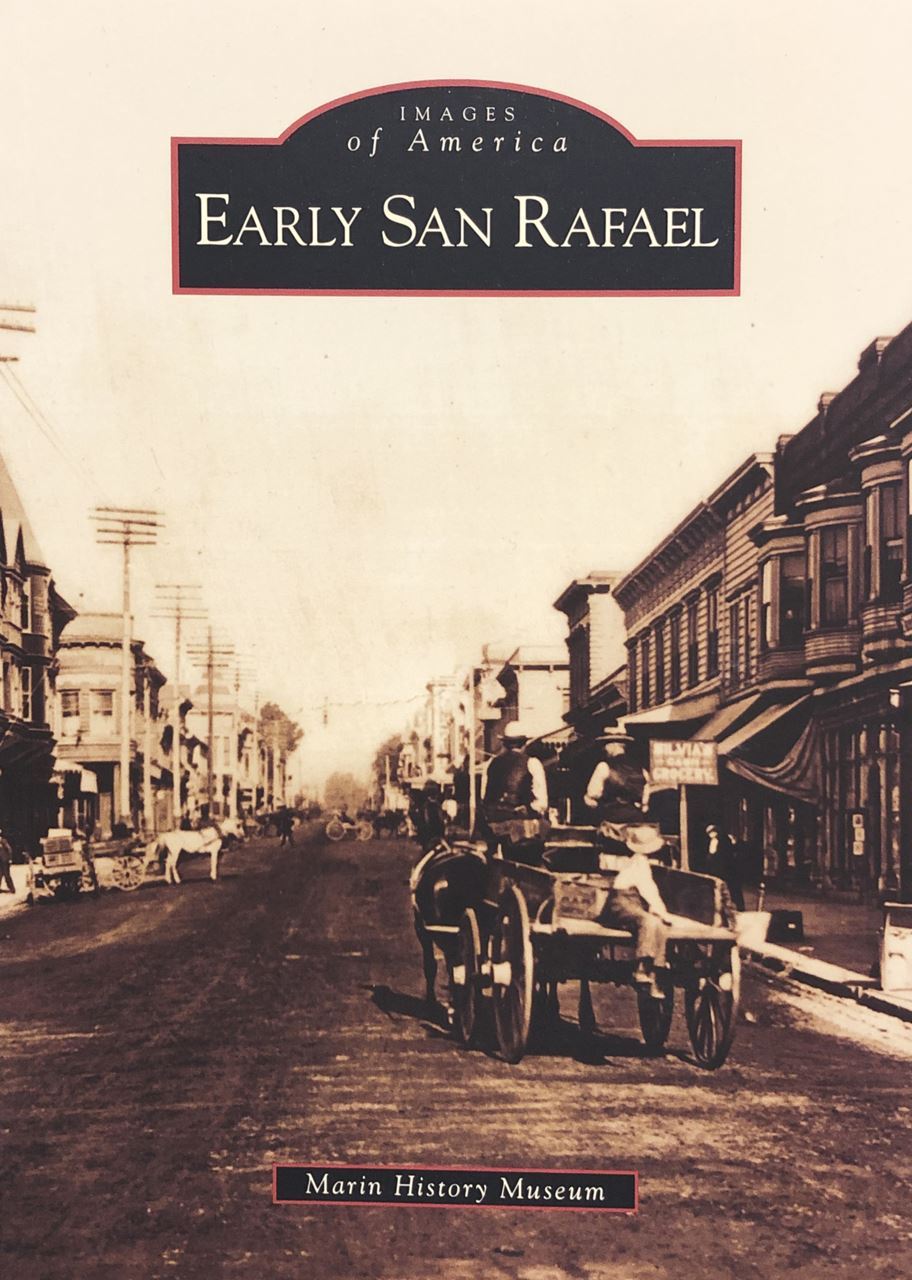 Books From the Marin History Museum Books From the Marin History Museum 
These books have either been written by the Museum or by someone affiliated with our organization. They can all be purchased online or at the Bookstore At The Boyd.
 Moments in History by Scott Fletcher Moments in History by Scott Fletcher
"Familiar Tales and Untold Stories"
The history of Marin County is intimately connected with the birth and early growth of the state of California. Marin is home to one of the last Spanish missions and the location of the lone battle of the Bear Flag Revolt, which led to California statehood. At that time, Marin was a pastoral paradise that supplied most of the raw materials for the exploding population of Gold Rush Era San Francisco. Fifty years later, its temperate climate and the devastation wrought by the 1906 Earthquake and fire brought on a veritable "land rush" to the region.
The photographs in this book capture moments in time that tell the story of a people and land that have shaped Marin's past, present, and future. Working closely with the staff of the Marin History Museum, Scott Fletcher has carefully selected images from the museum's collection and brought their stories to life in a series of articles that first appeared in the Marin Independent Journal newspaper. The image subjects are diverse, including landscapes, towns, people, businesses, homes, and modes of transportation representing all geographic areas of the county.
 Marriage, Murder & Betrayal in Nineteenth-Century California by Jo M. Haraf Marriage, Murder & Betrayal in Nineteenth-Century California by Jo M. Haraf
In 1832, the captain of the brigantine Catalina ordered Scotsman James Black, dying of typhus, abandoned at Monterey, California. Nursed by J. B. R. Cooper's wife, Black survived to hunt the last of California's sea otters, defend San Francisco from invading Russians under the direction of General Vallejo, and drive cattle north to feed hungry gold rush miners.
Black's ranching and dairy empire, founded on a single Mexican land grant, ultimately encompassed 20,000 Marin County acres. Black, his wife, and daughter enjoyed the privileges of the landed gentry until January 1864 when his cherished wife died in their son-in-law's dental chair. An obsessive resentment, excesses of whisky, and a scheming second wife consumed Black's bereavement.
Augustina learned after her father's death that she had been written out of his will. For four years and across two counties, she fought her stepmother for a fair portion of her father's $15,000,000 estate. After multiple notorious trials, Augustina gained a partial victory—but would she receive the land and gold the jury awarded her?
 Journal across the Plains by John Martin Verdenal and Domique François Verdenal, edited by Jo M. Haraf Journal across the Plains by John Martin Verdenal and Domique François Verdenal, edited by Jo M. Haraf
The Museum is delighted to share the Verdenal Journal, one of the gems of its collection, with lovers of Western history. In April 1852, twelve-year-old John Verdenal, his younger brother Dominique and their parents left St. Louis, Missouri in a wagon train heading for California. The brothers' travel journal details the people they encountered and their challenges traversing rivers, prairies, deserts and mountains. The book introduces the boys prior to departure and follows them and their descendants into the 21st century.
 Early San Rafael by The Marin History Museum Early San Rafael by The Marin History Museum
Written by Jocelyn Moss & Judy Coy, this book describes the early days of Marin up to WWII. Starting with the Coast Miwok then the early friars of Mission Dolores who chose San Rafael for its good weather and running streams. San Rafael grew fast thereafter―it was the first city in Marin County to incorporate, the first to build a railroad, and the first to build a luxury hotel. San Rafael is the seat of county government, the center of commerce, and a cosmopolitan community in a natural setting. The dusty village of long ago was refined by fine schools and churches, the coming of the library, and by the ambitious efforts of the San Rafael Improvement Club. These early efforts made this a charming place to live, with Victorian homes, sylvan streets, and historic buildings in the business district. The pioneers would be pleased with the state of today’s San Rafael.
 Modern San Rafael: 1940-2000 by The Marin History Museum Modern San Rafael: 1940-2000 by The Marin History Museum
This book begins where the first volume, Early San Rafael, left off. Writers Jocelyn Moss & Michelle Sarjeant Kaufman showcase how San Rafael changed dramatically in the years following World War II, and in the 1950s, the gentle hills with roaming cattle gave way to housing developments and shopping centers. Expansion of the city into Terra Linda, Marinwood, and Santa Venetia provided housing for all the new residents. The population soared, and to keep pace, new schools, new streets, and new ideas expanded the size and ambience of the town. The new Marin County Civic Center designed by Frank Lloyd Wright became an instant architectural icon. Not everything changed, and some of the old town remains today, adding to San Rafael's charm. The vibrant downtown, the attractive streets with Victorian homes, and the beautiful landscape close to San Francisco Bay have been preserved. San Rafael is a place where the healthy outdoor lifestyle meets a busy center of cultural activity, and the result is a great place to live.
|

